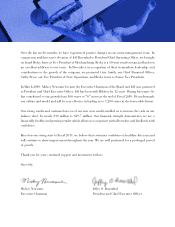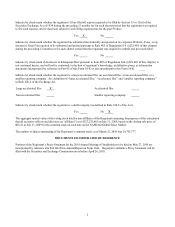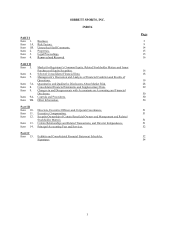Hibbett Sports 2010 Annual Report Download - page 13
Download and view the complete annual report
Please find page 13 of the 2010 Hibbett Sports annual report below. You can navigate through the pages in the report by either clicking on the pages listed below, or by using the keyword search tool below to find specific information within the annual report.9
Our Employees
As of January 30, 2010, we employed approximately 2,100 full-time and approximately 3,800 part-time
employees, none of whom are represented by a labor union. The number of part-time employees fluctuates
depending on seasonal needs. We cannot guarantee that our employees will not, in the future, elect to be
represented by a union. We consider our relationship with our employees to be good and have not experienced
significant interruptions of operations due to labor disagreements.
Employee Development. We develop our training programs in a continuing effort to service the needs of
our customers and employees. These programs are designed to increase employee knowledge and include video
training in all stores for the latest in technical detail of new products and new operational and service techniques.
Because we primarily promote or relocate current employees to serve as managers for new stores, training and
assessment of our employees is essential to our sustained growth.
We have implemented programs in our stores and corporate offices to ensure that we hire and promote the
most qualified employees in a non-discriminatory way. One of the most significant programs we have is Hibbett
University or “Hibbett U” which is an intensive, four-day training session held at our corporate offices and designed
specifically for store management.
Seasonality
We experience seasonal fluctuations in our net sales and results of operations. Customer buying patterns
around the spring sales period and the holiday season historically result in higher first and fourth quarter net sales.
In addition, our quarterly results of operations may fluctuate significantly as a result of a variety of factors, including
the timing of new store openings, the amount and timing of net sales contributed by new stores, merchandise mix
and demand for apparel and accessories driven by local interest in sporting events.
Item 1A. Risk Factors.
You should carefully consider the following risks, as well as the other information contained in this report,
before investing in shares of our common stock. If any of the following risks actually occur, our business could be
harmed. In that case, the trading price of our common stock could decline, and you might lose all or part of your
investment.
Risks Related to Our Business and Industry.
An extended downturn in the economy could affect consumer purchases of discretionary items, which could
reduce our net sales.
In general, our sales represent discretionary spending by our customers. The failure of U.S. government
programs to bolster the economy, a further slowdown in the U.S. economy or other economic conditions affecting
disposable consumer income, such as employment levels, inflation, business conditions, fuel and energy costs,
consumer debt levels, lack of available credit, interest rates and tax rates may adversely affect our business. A
reduction in overall consumer spending which causes customers to shift their spending to products other than those sold
by us or to products sold by us that are less profitable could result in lower net sales, decreases in inventory turnover or
a reduction in profitability due to lower margins. At this time, we are unable to determine the impact on our customers
and our business, if any, of programs adopted by the U.S. government to stabilize and support the economy.
The slower pace of our new store openings may negatively impact our net sales growth and operating income and
we may be unable to achieve our expansion plans for future growth.
The opening of new retail stores has contributed significantly to our growth in net sales. In light of the
challenging economic environment that has faced retailers and real estate developers over the past two years, we have
slowed down the pace of our new store openings. We expect that this pressure on the commercial market and
developers will continue throughout Fiscal 2011 and that we will only be able to increase our overall store base by
approximately 2% in Fiscal 2011 compared to 3% in Fiscal 2010 and 8% in Fiscal 2009. The slower pace of our new
store openings may negatively impact our net sales growth and operating income.
We have grown rapidly, primarily through opening new stores, growing from 67 stores at the beginning of
Fiscal 1997 to 767 stores at January 30, 2010. Our continued growth depends, in large part, upon our ability to open
new stores in a timely manner and to operate them profitably. Successful expansion is subject to various contingencies,
many of which are beyond our control. In order to open and operate new stores successfully, we must secure leases on
suitable sites with acceptable terms, build-out and equip the stores with furnishings and appropriate merchandise, hire
and train personnel and integrate the stores into our operations.
In addition, our expansion strategy may be subject to rising real estate and construction costs, available credit
to landlords and developers and landlord bankruptcies that could inhibit our ability to sustain our rate of growth. We
























